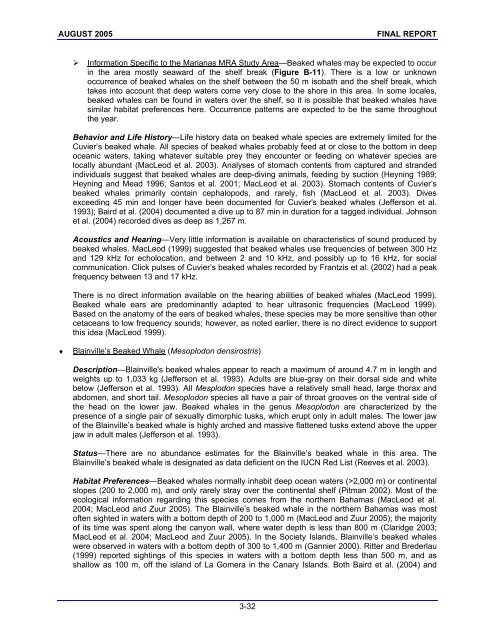Marine Resources Assessment for the Marianas Operating ... - SPREP
Marine Resources Assessment for the Marianas Operating ... - SPREP
Marine Resources Assessment for the Marianas Operating ... - SPREP
Create successful ePaper yourself
Turn your PDF publications into a flip-book with our unique Google optimized e-Paper software.
AUGUST 2005 FINAL REPORT<br />
In<strong>for</strong>mation Specific to <strong>the</strong> <strong>Marianas</strong> MRA Study Area—Beaked whales may be expected to occur<br />
in <strong>the</strong> area mostly seaward of <strong>the</strong> shelf break (Figure B-11). There is a low or unknown<br />
occurrence of beaked whales on <strong>the</strong> shelf between <strong>the</strong> 50 m isobath and <strong>the</strong> shelf break, which<br />
takes into account that deep waters come very close to <strong>the</strong> shore in this area. In some locales,<br />
beaked whales can be found in waters over <strong>the</strong> shelf, so it is possible that beaked whales have<br />
similar habitat preferences here. Occurrence patterns are expected to be <strong>the</strong> same throughout<br />
<strong>the</strong> year.<br />
Behavior and Life History—Life history data on beaked whale species are extremely limited <strong>for</strong> <strong>the</strong><br />
Cuvier’s beaked whale. All species of beaked whales probably feed at or close to <strong>the</strong> bottom in deep<br />
oceanic waters, taking whatever suitable prey <strong>the</strong>y encounter or feeding on whatever species are<br />
locally abundant (MacLeod et al. 2003). Analyses of stomach contents from captured and stranded<br />
individuals suggest that beaked whales are deep-diving animals, feeding by suction (Heyning 1989;<br />
Heyning and Mead 1996; Santos et al. 2001; MacLeod et al. 2003). Stomach contents of Cuvier’s<br />
beaked whales primarily contain cephalopods, and rarely, fish (MacLeod et al. 2003). Dives<br />
exceeding 45 min and longer have been documented <strong>for</strong> Cuvier's beaked whales (Jefferson et al.<br />
1993); Baird et al. (2004) documented a dive up to 87 min in duration <strong>for</strong> a tagged individual. Johnson<br />
et al. (2004) recorded dives as deep as 1,267 m.<br />
Acoustics and Hearing—Very little in<strong>for</strong>mation is available on characteristics of sound produced by<br />
beaked whales. MacLeod (1999) suggested that beaked whales use frequencies of between 300 Hz<br />
and 129 kHz <strong>for</strong> echolocation, and between 2 and 10 kHz, and possibly up to 16 kHz, <strong>for</strong> social<br />
communication. Click pulses of Cuvier’s beaked whales recorded by Frantzis et al. (2002) had a peak<br />
frequency between 13 and 17 kHz.<br />
There is no direct in<strong>for</strong>mation available on <strong>the</strong> hearing abilities of beaked whales (MacLeod 1999).<br />
Beaked whale ears are predominantly adapted to hear ultrasonic frequencies (MacLeod 1999).<br />
Based on <strong>the</strong> anatomy of <strong>the</strong> ears of beaked whales, <strong>the</strong>se species may be more sensitive than o<strong>the</strong>r<br />
cetaceans to low frequency sounds; however, as noted earlier, <strong>the</strong>re is no direct evidence to support<br />
this idea (MacLeod 1999).<br />
♦ Blainville’s Beaked Whale (Mesoplodon densirostris)<br />
Description—Blainville's beaked whales appear to reach a maximum of around 4.7 m in length and<br />
weights up to 1,033 kg (Jefferson et al. 1993). Adults are blue-gray on <strong>the</strong>ir dorsal side and white<br />
below (Jefferson et al. 1993). All Mesplodon species have a relatively small head, large thorax and<br />
abdomen, and short tail. Mesoplodon species all have a pair of throat grooves on <strong>the</strong> ventral side of<br />
<strong>the</strong> head on <strong>the</strong> lower jaw. Beaked whales in <strong>the</strong> genus Mesoplodon are characterized by <strong>the</strong><br />
presence of a single pair of sexually dimorphic tusks, which erupt only in adult males. The lower jaw<br />
of <strong>the</strong> Blainville’s beaked whale is highly arched and massive flattened tusks extend above <strong>the</strong> upper<br />
jaw in adult males (Jefferson et al. 1993).<br />
Status—There are no abundance estimates <strong>for</strong> <strong>the</strong> Blainville’s beaked whale in this area. The<br />
Blainville’s beaked whale is designated as data deficient on <strong>the</strong> IUCN Red List (Reeves et al. 2003).<br />
Habitat Preferences—Beaked whales normally inhabit deep ocean waters (>2,000 m) or continental<br />
slopes (200 to 2,000 m), and only rarely stray over <strong>the</strong> continental shelf (Pitman 2002). Most of <strong>the</strong><br />
ecological in<strong>for</strong>mation regarding this species comes from <strong>the</strong> nor<strong>the</strong>rn Bahamas (MacLeod et al.<br />
2004; MacLeod and Zuur 2005). The Blainville’s beaked whale in <strong>the</strong> nor<strong>the</strong>rn Bahamas was most<br />
often sighted in waters with a bottom depth of 200 to 1,000 m (MacLeod and Zuur 2005); <strong>the</strong> majority<br />
of its time was spent along <strong>the</strong> canyon wall, where water depth is less than 800 m (Claridge 2003;<br />
MacLeod et al. 2004; MacLeod and Zuur 2005). In <strong>the</strong> Society Islands, Blainville’s beaked whales<br />
were observed in waters with a bottom depth of 300 to 1,400 m (Gannier 2000). Ritter and Brederlau<br />
(1999) reported sightings of this species in waters with a bottom depth less than 500 m, and as<br />
shallow as 100 m, off <strong>the</strong> island of La Gomera in <strong>the</strong> Canary Islands. Both Baird et al. (2004) and<br />
3-32
















